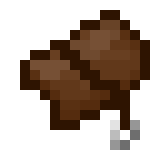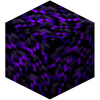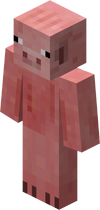| Java Edition |
| ||||
|---|---|---|---|---|---|
| Bedrock Edition |
| ||||
| Minecraft Education |
| ||||
| Legacy Console Edition | |||||
| New Nintendo 3DS Edition | |||||
Since the beginning of Minecraft's development, there have been a number of features that were removed from the game. These features may have been replaced, or a developer decided against the feature later on.
Note that this page only documents game features that were removed, features of a particular game element that were removed are noted in that element's history.
Blocks and items
Horse saddle

The horse saddle icon used in the inventory.
Horse Saddles were items that were added in 13w16a, along with horses that worked just like regular saddles, but for horses instead of pigs. Taming a horse was required before putting a horse saddle on it. The horse saddle was craftable using the following recipe:
- Template:GridTemplate:GridTemplate:Grid
Template:GridTemplate:GridTemplate:Grid
Template:GridTemplate:GridTemplate:Grid
The item ID used was 416, which refers to the armor stand in current versions.
Horse saddle items were later removed from the game in 13w18a, and normal saddles are now used for both pigs and horses.[1][2]
Infinite Water Source
The Infinite Water Source was a block that would create infinite water, which would replicate infinitely to fill up volumes. They were added originally in Indev (January 24, 2010) to allow for infinite lakes on floating maps.[3]
It was available as block ID 52, until it was replaced with the monster spawner in Infdev Seecret Friday 2 (June 25, 2010).
- Infinite Water.png
- Gears on 52 53.png
Gears do not show up on non-solid blocks, but do on the Infinite Water Source and Infinite Lava Source, proving that they are solid blocks.
Infinite Lava Source
Similar to the infinite water source, the Infinite Lava Source was a block that created infinite lava which would replicate infinitely to fill up volumes. It was also added in Indev (January 24, 2010).
It was available as block ID 53, until it was replaced with oak stairs in Alpha 1.0.0 (June 28, 2010).
- Infinite Lava.png
Locked chest
Locked chests were an April Fools block. Pressing use on the chest would bring up a screen, and clicking on the "Go to Store" button would forward you to the "Minecraft Store".
Generated structures
Brick pyramid
A brick pyramid spawned on a small island in the middle of the ocean.
For a brief time, brick pyramids were large structures that generated far away from the spawn point. These pyramids were completely solid; they had no interior rooms. A strange quality about these pyramids is that if one dug under it, a layer of dirt and stone extended under the pyramid. This suggests it spawned right on top of the terrain instead of being a complete pyramid with the bottom underground (such as desert temples). Pyramids were removed in later versions of Infdev.
Obsidian wall
The obsidian walls in Infdev
Obsidian walls were used in Infdev to mark the positions of the cardinal directions. This created two intersecting planes extending just above the surface of the solid material that surrounds them. This has long since been removed.
Mobs
Beast Boy, Black Steve, Steve, Rana
Beast Boy, Black Steve, Steve and Rana were human mobs originally in-game as a test during the Indev phase. They were made by "Dock", Minecraft's past artist, and were removed from the game when Dock left the development team in early 2010. These mobs had no animation and glided around in the same pose. Upon death, Beast Boy, Black Steve and Steve could drop 1-2 string, 1-2 feathers, 1-2 gunpowder and 0-1 flint and steel, while Rana could drop 0-2 apples, 0-5 roses and 0-2 feathers. Beast Boy, Black Steve and Steve each had 5![]()
![]()
![]() while Rana had 13
while Rana had 13![]() × 6.5.
× 6.5.
Human
Humans were hostile mobs which take the form of clones of the default skin.
Generic villager
Generic villagers were a type of villager. In 1.3.1, the ability to spawn them was added, though it required external tools or mods. In 1.7 and above, they could be spawned using /summon Villager ~ ~ ~ {Profession: -1}. They only had one trade: 7-9 gold ingots for 1 emerald. In 14w02a, due to changes in the trading system, attempting to trade with generic villagers will crash the game. In 14w20a, generic villagers were removed from the game, as villagers with negative profession IDs become farmers.
Unused
These features never had any use in game.
Cog
On January 25, 2010, Notch posted a video of the cogs being placed onto the wall of a cliff.[4]
In Indev on January 26, 2010, the code for cogs (originally named Gear) was added. It could only get obtained by inventory hacking and was invisible in the inventory. When hacked into the game, cogs could only be placed on a side of any block, placing them in a space where two sides are next to each other would cause two cogs to appear on both sides. Placed cogs were impossible to destroy; any mining directed at a cog phased through to the block behind it, much like water. If the block a cog was on was destroyed, the cog was not removed, but oddly, was invisible. The cog still existed in the map and would show up again if a solid block was replaced. Cogs placed in mid-air using a map editor were also invisible and would show up if a block was placed next to them. Cogs can be only removed using water to flow on them. A cog's sprite consisted of two parts; the center rod and the animated gear.
In Infdev on February 27, 2010, Gear was renamed to Cog, and later on June 27, 2010, it was removed.
Cogs had a data value of 55, which was replaced by redstone in Alpha 1.0.1.
Crying obsidian
Crying obsidian was a texture in Minecraft for an abandoned project to implement a spawn-point changing obelisk.[5][6][7][8] It was abandoned after the introduction of beds.[9] It would have been crafted with an obsidian block and lapis lazuli.[10]
The texture for crying obsidian was removed in Beta 1.5.
On February 9, 2012, Jeb was asked "Can you bring back Crying Obsidian or add some new color/texture blocks?" to which he responded "As soon as I've made preparations for more texture space."[11]
Furniture
Chair from Indev's terrain.png file.
In Indev's terrain.png were two textures which might be interpreted as a chair (side and front). The actual purpose of those textures is unknown. The second texture might be the side view of a table. On Notch's blog, The Word of Notch, furniture, and more specifically chairs, are mentioned a few times.[12][13][14][15]
Pigman
Minecraft user Miclee came up with the idea for pigmen.[16] He was given the Bacon Cape as a reward, but when Notch was asked for personal capes by other users, the Bacon Cape was taken away from Miclee to prevent further commotion.
Notch mentioned April 25, 2011 that he might add pigmen as villages' townspeople.[17] Although in the Beta 1.9 pre-releases, a different villager mob was introduced.
In 1.6.2, the texture file was removed from Minecraft.
Play Tutorial Level button
An unclickable Play Tutorial Level button was added during Indev. It could be found on the main screen. It was finally removed during the transition from Alpha to Beta stage, but no such tutorial level existed between Indev and Beta.
Skis
skis texture
A texture known in the game files as "skis.png", was added in the 1.4.6 update. Its textures were added by Dinnerbone as a red herring.[18] The texture was removed in 1.6 (Horse Update).
Studded armor
Studded armor was several sprites that were added sometime around Indev 0.31 in items.png. They were taken from Notch's unfinished game, Legend of the Chambered, along with other armor sprites. The sprites were never implemented into gameplay and were eventually removed.
Other
Calm4.ogg
Calm4.ogg was a music file (alongside the other tracks) that was beta-tested and created by Notch himself.
It consists of an up-beat, battle-like tune. At 1:36 in the song, you can hear Notch saying "Mojang Specifications" in a slowed-down voice.
The track was released around Alpha 1.1.1 (Seecret Saturday 10), but it is unknown when and why it was omitted from the downloaded game files. As such, players who had the game while the song was still in it will continue to hear it being played, as the game will play any song in the .minecraft/resources/music folder.
Isometric screenshot
In the Indev versions of the game, you can take a screenshot of the map from an isometric perspective using F7.
Themes
A Theme is the general style the level generator uses to create maps. Added in 0.31 update in January 7, 2010, it dramatically affects Indev mode's game mechanics (such as monster spawn zones and boundary liquid). Paradise and Woods themes were added in Indev update on February 14, 2010. Themes were removed for later on in the middle of infdev and are comparable to biomes in Alpha, Beta, and current Minecraft versions.
Void fog
Void fog as depicted in Beta 1.8

The limit of the player's view would reduce with depth
Starting in Beta 1.8, black Void fog existed which increased with depth as the player descended past Y=17. As the player traveled deeper, the fog at the edge of the render distance would become grow closer, until the player reached the deepest depths, where visibility was reduced to just a few blocks, beyond which lay only blackness. There were also dark gray void particles that appeared at level 16 and below, plus in the void.
Void fog and the void particles were removed in snapshot 14w34c for release version 1.8. The main reason for its removal was to increase performance.[19]
Winter mode
Winter mode was a randomly occurring map type for Minecraft Alpha. It was added on the 9th of July, 2010 and was the first other "biome" than the generic one to appear in Minecraft. It was removed in the Halloween Update.
Dispensing command blocks
Prior to version 1.8.6, dispensers would have the ability to place a command block that it had when activated. This feature was removed to solve a security issue.[20][21]
References
- ↑ https://twitter.com/jeb_/status/327817745360101376
- ↑ https://twitter.com/jeb_/status/327819210455650304
- ↑ http://notch.tumblr.com/post/333135179/i-should-be-sleeping-but
- ↑ http://www.youtube.com/watch?v=V9H_ymjT-4E&t=2m12s
- ↑ https://twitter.com/jeb_/status/58821868924309504
- ↑ User talk:Jeb mojang#Your opinion on this deletion
- ↑ https://twitter.com/jeb_/status/40350003591380992
- ↑ https://twitter.com/jeb_/status/52994778224275456
- ↑ https://twitter.com/jeb_/status/140410431394160640
- ↑ https://twitter.com/jeb_/status/140411053250064384
- ↑ https://twitter.com/jeb_/status/167547923041751040
- ↑ wordofnotch:659506746
- ↑ wordofnotch:660061390
- ↑ wordofnotch:666612436
- ↑ wordofnotch:673782427
- ↑ https://twitter.com/notch/status/28832121068
- ↑ https://twitter.com/notch/status/62531431175421952
- ↑ https://twitter.com/Dinnerbone/status/283392354851901440
- ↑ https://twitter.com/TheMogMiner/status/501766046681153536
- ↑ https://twitter.com/SeargeDP/status/603200679532978176
- ↑ https://bugs.mojang.com/browse/MC-80671?focusedCommentId=228546&page=com.atlassian.jira.plugin.system.issuetabpanels:comment-tabpanel#comment-228546
| Help | |||||||||||||||||||
|---|---|---|---|---|---|---|---|---|---|---|---|---|---|---|---|---|---|---|---|
| Menu screens |
| ||||||||||||||||||
| Game customization | |||||||||||||||||||
| Editions |
| ||||||||||||||||||
| Miscellaneous | |||||||||||||||||||








